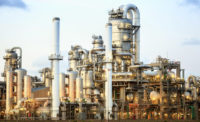3D printing or additive manufacturing allows users to “print” a variety of items, from airplane parts to prosthetic limbs. 3D printing is still a relatively new technology and there are many gaps in the information available about health and safety implications. As with many innovations, workers are the first groups exposed to potential hazards. Based on prior knowledge from air pollution research and industrial processes (e.g., welding) there are concerns over 3D printing emissions and their potential impact on workers’ health.
MakerBot, a Brooklyn-based manufacturer of 3D printers, has partnered with the NIOSH Nanotechnology Research Center (NTRC) Advanced Materials and Manufacturing field team to conduct measurements to characterize 3D printer emission rates. Several MakerBot 3D printer models and types of filament were evaluated. The thermoplastic filament materials used in the 3D printers at the time of the study included True Orange PLA (polylactic acid), True Yellow ABS (acrylonitrile butadiene styrene), and Slate Grey Tough PLA (impact-resistant PLA).
At MakerBot, the NIOSH field team used two different methods to evaluate and compare emissions. The field team evaluated particulate and volatile organic compounds (VOCs) emitted from simultaneous operation of up to 20 desktop 3D printers in a conference room. Emissions from individual 3D printers were also evaluated using a portable isolation chamber developed by NIOSH researchers. Methods included:
- collecting filter-based area air samples for detection of fine and ultrafine particulate by electron microscopy and gravimetric methods;
- collecting area air samples for VOCs using charcoal tubes, vacuum cylinders, and direct reading instruments;
- using direct reading data logging particle counters to monitor the number and size classes of airborne particles.
Findings
During 3D printing, respirable particulate concentrations were non-detectable (below 0.03 micrograms per cubic meter, µg/m3) and VOC concentrations were well below applicable occupational exposure limits (OELs). Particulate and VOC concentrations measured in the conference room during 3D printing with 20 printers were much lower than those measured in the test chamber. This was likely due to general dilution as a result of the conference room’s larger ventilated space compared to the enclosed test chamber. However, local exhaust ventilation could reduce or eliminate the concentrations of ultrafine particle emissions that were measured in the conference room.
Another key finding of our study was that True Orange PLA filament produced lower ultrafine particle emissions compared to published results from other emission tests in the scientific literature such as He, et al [2007], Stephens et al. [2013], and Stefaniak et al. [2017]. However, additional research should be conducted to identify other lower emitting filaments as an option to reduce ultrafine emissions in the workplace and to develop a system to categorize 3D printer emission rates.
Occupational exposures and potential exposure-related health effects associated with 3D printing/additive manufacturing are areas that require further evaluation and research. There are currently no OELs for 3D printer emissions and potential toxicological effects of exposure to emissions from 3D printing are not fully understood. While more information is being gathered and assessed related to these issues, we recommend the following actions to reduce potential for uncontrolled emissions from filaments used in the 3D printers.
Recommendations
Our recommendations are based on an approach known as the hierarchy of controls, and would be applicable for all brands of 3D printers and filaments. This approach groups actions by their likely effectiveness in reducing or removing hazards. In most cases, the preferred approach is to eliminate hazardous materials or processes and install engineering controls to reduce exposure or shield employees.
- Ventilation is an important engineering control to help control/reduce emissions from 3D printers. Examples of ventilation controls could include single unit local exhaust ventilation system, snorkel fume extractors, or for situations where multiple printers are used, operating 3D printers on enclosed ventilated racks that exhaust to the outdoors may be appropriate. These ventilation approaches may reduce energy costs compared to general dilution ventilation. Because the majority of 3D printer emissions are nanoparticles, another option would be to exhaust the air from printers through a room air cleaner equipped with high-efficiency particulate air (HEPA) filtration.
- More research is needed to identify additional low emitting filaments for use in 3D printers so that filament selections can be made based on low emission rate in addition to other filament properties. Low emitting filaments will reduce energy costs associated with ventilation and filtration controls and may be particularly important for workplaces in leased facilities or other settings where ventilation modifications are not feasible or allowable.
- Integrate local exhaust duct connections and/or particulate filtration into the design of individual 3D printers to reduce ultrafine particle emissions into the indoor work environment.
Use of 3D printers is likely to continue to increase. As much remains unknown about 3D printer emissions, NIOSH would like to conduct further evaluations and research to assess additional additive manufacturing scenarios, processes, or exposures. Please contact Kevin L. Dunn at kgd8@cdc.gov or use the comment box on the NIOSH Science Blog post web page if you are interested in collaborating with NIOSH on this work.
References
He, C. Morawska, L. and Taplin, L. [2007]. Particle Emission Characteristics of Office Printers. Environmental Science & Technology 2007 41 (17), 6039-6045 .DOI: 10.1021/es063049z
Stephens, B. Azimi, P. El Orch, Z. Ramos, T. Ultrafine particle emissions from desktop 3D printers. Atmospheric E nvironment 2013 (79) 334-339. https://doi.org/10.1016/j.atmosenv.2013.06.050
Aleksandr B. Stefaniak, Ryan F. LeBouf, Jinghai Yi, Jason Ham, Timothy Nurkewicz, Diane E. Schwegler-Berry, Bean T. Chen, J. Raymond Wells, Matthew G. Duling, Robert B. Lawrence, Stephen B. Martin Jr., Alyson R. Johnson & M. Abbas Virji (2017) Characterization of chemical contaminants generated by a desktop fused deposition modeling 3- dimensional Printer, Journal of Occupational and Environmental Hygiene, 14:7, 540-550, DOI:10.1080/15459624.2017.1302589



